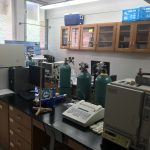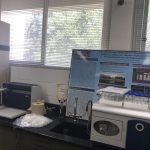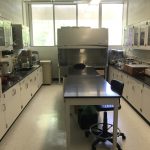Areas of Specialization
 My primary area of specialization is in “Environmental Biogeochemistry”. My research focuses on the environmental cycling, regulation, implication, and the biological role of pollutants released to the environment by different anthropogenic activities. In our research group, we use fundamental knowledge in thermodynamics, geochemistry, microbiology, and toxicology to develop environmental friendly techniques for pollution prevention as well as for remediation of contaminated waters and soils/sediments.
My primary area of specialization is in “Environmental Biogeochemistry”. My research focuses on the environmental cycling, regulation, implication, and the biological role of pollutants released to the environment by different anthropogenic activities. In our research group, we use fundamental knowledge in thermodynamics, geochemistry, microbiology, and toxicology to develop environmental friendly techniques for pollution prevention as well as for remediation of contaminated waters and soils/sediments.
Research Summary
 My current research follows two main tracks in which fundamental knowledge in thermodynamics, geochemistry, microbiology, and toxicology is used to study the fate and impacts of pollutants in natural systems, and ultimately, to develop environment friendly techniques for remediation of contaminated systems. With regard to remediation, the focus has been on the development of cost effective remedial approaches for metal-contaminated soils, sediments and water effluents.
My current research follows two main tracks in which fundamental knowledge in thermodynamics, geochemistry, microbiology, and toxicology is used to study the fate and impacts of pollutants in natural systems, and ultimately, to develop environment friendly techniques for remediation of contaminated systems. With regard to remediation, the focus has been on the development of cost effective remedial approaches for metal-contaminated soils, sediments and water effluents.
- The first research track aims at developing an “understanding of the complex interplay between engineered nanomaterials and both ecosystem functions and living organisms”. This is because nanotechnology has not only the potential to benefit environmental quality through pollution prevention, treatment, and remediation; but also to lead to serious environmental problems. The long-term adverse impacts of engineered nanomaterials on ecosystems and human health remain largely unknown.
- The second track focuses on the “biogeochemistry of trace metals”. This research emphasizes studies on the environmental cycling, regulation, implication, and the biological role of pollutants released into the environment by different anthropogenic activities. Current research topics include the tailoring and use of sorbents in the remediation of metal-contaminated systems, metal resource recovery coupled to the cleanup of waste streams, and adding value to waste materials through use in pollution control.
Research Narrative
Environmental Application and Implications of Nanotechnology
My research in environmental nanotechnology encompasses both the application and implication aspects of nanotechnology.
- Environmental Applications of Nanotechnology — This research program focuses on improving the current understanding of the interactions between engineered nanomaterials (ENMs) and both solid and aqueous phases. The ultimate objective of this research is the development of methods for environmental pollution prevention and remediation of contaminated effluents. So far, this research has led to the following findings. First, sorption-desorption processes can be used to produce highly purified species of carbon nanotubes for targeted applications. Second, metallic nanomaterials, nano-zevalent iron in this case have shown the potential for use in water treatment, with emphasis on the removal of mercury from contaminated aqueous effluents. My specific role in this work has been on (1) use of water chemistry knowledge, namely metal speciation and interactions with solid surfaces to optimize the efficiency of metal removal from aqueous solution using ENM-based technologies. Additionally, the determined affinities of CNTs for either organic or non-organic solid phases have led to ongoing studies on the development of predictive tools on the potential of ENMs to bio-accumulate and induce toxicity.
- Environmental Implications of ENMs — The fast growing field of nanotechnology focuses on novel materials and devices for electronics, photonics and renewable energy applications. While engineered nanomaterials (NMs) offer an array of properties that enable unique control over the function of devices, this same broad array of properties creates a challenge in identifying the potential ramifications of these materials to the environment and human health. Unfortunately, significant knowledge gaps persist in our current understanding of the environmental fate of NMs as well as the implications of their interactions with living organisms. Chemical elements used in the production of NMs could lead to environmental dysfunctions due to: (i) the potential toxicity of these elements and their derivatives; (ii) the nanometer-sizes that make ENMs prone to bio-uptake/bioaccumulation and (ii) the large surface area, which might lead ENMs to act as carriers/delivers of pollutants adsorbed onto them. This research program combines toxicological, biogeochemical, and modeling studies to advance discovery and understanding of the behavior, fate, and impact of ENMs in the environment.
My contribution to science and engineering in this specific research area consists of the development of sustainable approaches to help eliminate the toxicity of NMs prior to being used in different environmental applications, while maintaining the relevant physicochemical properties of nano-sized particles.
Environmental Biogeochemistry of Metals and Remediation of Contaminated Systems
 The ultimate goal of this research program is to combine the remediation of metal contaminated soils and sediments with metal resources recovery. Currently, soil remediation by in-situ immobilization is a method of choice when dealing with large-scale operations, thanks to the ease of its application and relatively low cost. However, while the goal of in-situ immobilization of metals in soils is primarily to reduce/eliminate the contamination of water resources as well as metal bioavailability, I believe that with regard to metal pollution of soils and sediments, the paradigm should shift from the current “pollution control and prevention” to “pollution control and metal resources recovery”. The recovery and recycling of metals from anthropogenic waste streams could be – not only a cost effective way to meet the needs of our society – but also an environmental beneficial route to valuable metal elements. Therefore, my contribution to science and engineering in this specific research area has been the development and fine-tuning of remediation of metal contaminated soils through a combination of sorption on iron particles, followed by magnetic retrieval of metal-particle complexes from treated soils and plant bioavailability studies. These steps are being evaluated in different types of soils contaminated with a wide range of metals. Following the optimization of the treatment step, the research will then focus on resource recovery aspect.
The ultimate goal of this research program is to combine the remediation of metal contaminated soils and sediments with metal resources recovery. Currently, soil remediation by in-situ immobilization is a method of choice when dealing with large-scale operations, thanks to the ease of its application and relatively low cost. However, while the goal of in-situ immobilization of metals in soils is primarily to reduce/eliminate the contamination of water resources as well as metal bioavailability, I believe that with regard to metal pollution of soils and sediments, the paradigm should shift from the current “pollution control and prevention” to “pollution control and metal resources recovery”. The recovery and recycling of metals from anthropogenic waste streams could be – not only a cost effective way to meet the needs of our society – but also an environmental beneficial route to valuable metal elements. Therefore, my contribution to science and engineering in this specific research area has been the development and fine-tuning of remediation of metal contaminated soils through a combination of sorption on iron particles, followed by magnetic retrieval of metal-particle complexes from treated soils and plant bioavailability studies. These steps are being evaluated in different types of soils contaminated with a wide range of metals. Following the optimization of the treatment step, the research will then focus on resource recovery aspect.